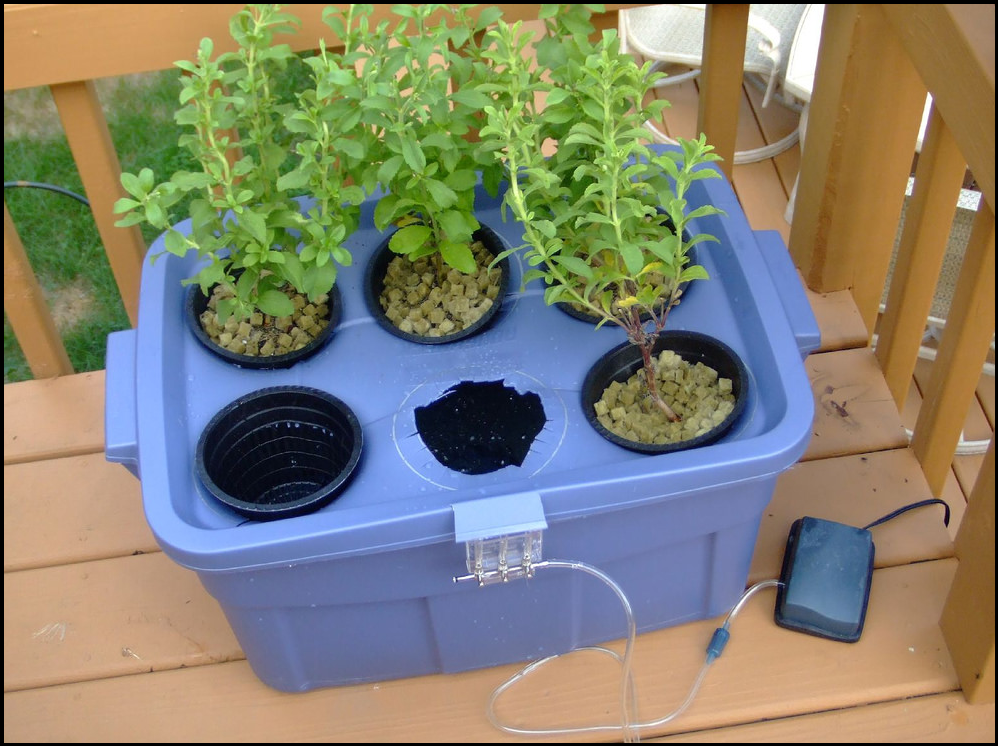Hydroponic Wick System

Another DIY wick system in a plastic tub. Note the pump and air hose. These are to keep the nutrient system aerated within the tank, to prevent stratification and uneven nutrient distribution. The pump is not necessary to the system, but it's a nice addition if power is available. Photo courtesy of Reformation Acres.
You are on Page 3 of our six page series on hydroponic wick system section. Click on any of the below pages to jump to that page.
Page 1 Page 2 Page 3 Page 4 Page 5 Page 6
What Growing Media Is Used In This System?
The choice of growing media is always an important consideration regardless of which hydroponic approach is used. For wicking systems, it’s even more critical. As we touched on already, nutrient solution is distributed into each container via a wick, which pulls nutrient solution from the nutrient tank. The growing media must then pull nutrient solution from the wick and distribute it throughout the rest of the container. Different growing media have different wicking effectiveness, and sometimes any given growing medium simply cannot wick enough nutrient solution to adequately distribute nutrient throughout the container.
Characteristics to look for in growing media would be, first and foremost, extremely high capillary action. This can be predicted to a certain extent by the media particle size, and the size of the pores or spaces between those particles. So for instance, lava rock is a growing medium with extremely large particle size, sometimes 2” across. The spacing between these particles is also extremely large, sometimes at least ½” or more. While the lava rock surface is relatively porous and can hold quite a bit of nutrient solution, the spaces between particles would make capillary action difficult at best. Thus, lava rock would probably not be a good choice. At the other end of the spectrum, fine sand would have both extremely small particle size, and inter-particle spaces. That material would probably show very high wicking properties. Most other materials, such as coir, perlite/vermiculite, rough sand/gravel, hydroton, rockwool, etc, would fall somewhere in between.
In addition to wicking ability, other relevant issues are:
- The intended plants, specifically their planting density, mature size and feeding needs
- The weight of the growing media
- The type and strength of container
- The size and shape of container (for instance, a round pot versus a square pot versus a long narrow rectangular grow tray)
- Whether the growing media needs to be reusable over multiple crops or growing seasons
- Whether the growing media needs to be washed or sterilized between crops
- Which wick material will be used
- The surrounding climate, notably the temperature and relative humidity.
Given all the variables, the best way to determine which material(s) are best suited for any given crop in any given hydroponic system, would be to test it. One test would be to set up a small test container (or set of containers), with as close to the intended system setup as possible: use the intended wick, place the nutrient solution reservoir in the same location relative to the container(s), and then fill each container with one of the candidate types of growing media. For this test, using live plants would actually be too slow a process, because it would take days or weeks before they would show damage from lack of nutrients. A faster method would be to simply use paper or cardboard strips, buried in various locations around the containers. The strips could then be monitored once the test begins, to see how quickly they become wet and how long they stay wet. Another option, albeit more complicated, would be to get a pack of soil moisture sensors (which can often be found at home improvement centers and gardening centers), and place those at various locations in the container. Many of those have the added benefit of showing a range of moisture conditions. Once all the components and materials are in place, fill the nutrient tank with water (or colored water). Test this system not just for an afternoon, but ideally for at least several days, if not weeks. A single test run may initially show that any given growing media will move water (and by extension, nutrient solution) throughout the container. However, an extended test run may show that the container will develop dry spots, or even abnormally wet spots, which would impact its effectiveness for the intended crop. Also keep in mind that container shape will affect how nutrient solution will move through the growing media. The same growing media and wick will show different results in round pots versus long narrow grow trays.
Once several different suitable growing media options have been identified, further tests can narrow down which of those are the best choice. It is entirely possible that several growing media options will have comparable performance traits. At that point, other variables (for instance, cost) will help determine which growing medium is the best candidate.
You are on Page 3 of our six page series on hydroponic wick system section. Click on any of the below pages to jump to that page.